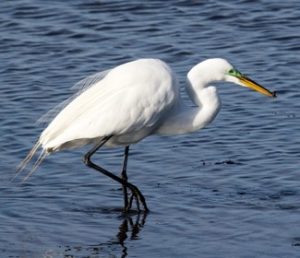Sheepshead
Archosargus probatocephalus

Image by Robert Aguilar, Smithsonian Environmental Research Center, CC BY 2.0
Physical: The sheepshead is a silver colored fish with 5-6 dark vertical stripes. Unlike other fish, they have human-like teeth including incisors and molars, as well as rounded grinding teeth. They have sharp spines in the dorsal (back) and anal (bottom) fins. The long pectoral (side) fins reach all the way back to the anal fin. Adults grow up to 30 in (76.2 cm).
Habitat: Their range spans from Nova Scotia to the northern Gulf of Mexico, and south to Brazil. While the Barnegat Bay is part of this range, sheepshead are more common to the south, meaning any individuals found here are likely to be southern strays. Sheepshead prefer areas with structure, like oyster reefs, seawalls, and tidal creeks. They prefer brackish water environments, but will sometimes head to warmer freshwater areas during the winter. Juveniles reside in seagrass beds and muddy bottom areas.
Feeding: Sheepshead are omnivores. In addition to plant material, they eat small fishes, crabs, oysters, clams, and crustaceans, using their teeth to crush shells and scrape barnacles from hard surfaces. Juveniles eat zooplankton, worms, and midge larvae.
Breeding: Spawning takes place in March and April, as adults migrate offshore in late winter or early spring. Sheepshead spawn incrementally, anywhere from once daily to once every 20 days during the season. Females lay anywhere from 1,100 to 250,000 eggs per batch.

Sign up for email or connect through social media.